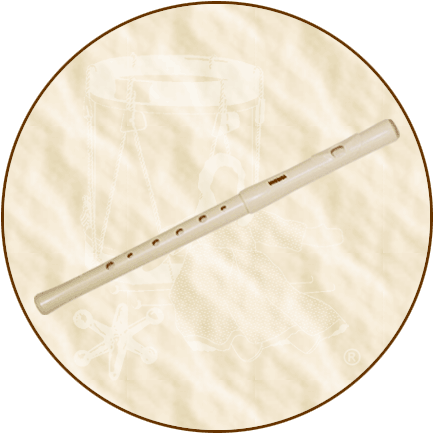.
Continued from product description on
Folk Instruments' Page Two...
Historical
Background: The fife is a wind instrument that is believed
to have originated in China as early as 800 B.C. Also known as
a "cross flute," or "traverse flute," the
fife was introduced through Byzantium to Europe sometime during
the 1100s. The fife soon became an important folk music instrument
in the region east of the Rhine River.
The name "fife" came to be when German and Swiss
peasants adopted this instrument into their cultures. Germans
called their wind instrument "zwerchpfeiffen" (or "cross
fife"), while the Swiss called it "schweitzerpfeiffen"
(or "Swiss fife"). From these two countries, the fife's
popularity spread to the rest of Europe during the later part
of the Middle Ages.
Since Swiss army troops began using fifes in the early 1500s,
they have been closely associated with military music. In wartime,
Swiss military units used fifes and field drums for control and
command purposes during military engagements. In 1534, the French
army made a regulation that there would be two fifes and two
drums for each company (1,000) of troops. By 1539, fifes and
drums were being used in England at Christmas festivals. The
use of fifes and drums were eventually adopted by the English
army during the 1550s and 1560s. By this time, one could hear
them played on theatrical stages in London as well as elsewhere
in England.
Michael Praetorius described the Swiss fife in the 1600s as
being two feet long and had a range from G1 of the 1st octave
to C3 of the 3rd octave. During his reign, King James II (1685-1688)
prohibited his English army from using fifes. The fife had other
critics in England during this period. Oliver Cromwell called
the fife a "profane instrument" and William Shakespeare
-- in his plays "Othello" and "The Merchant of
Venice" -- referred to the fife's "vile squealing"
and "ear-piercing" qualities.
Even though it fell from grace in England, the fife continued
to be a popular instrument with the German and French peoples.
In 1745, the fife was reintroduced to the British Foot Guards
by a young German fifer. No matter what an Englishman thought
about the fife's sounds, it was still a very good instrument
for helping soldiers march in cadence. Eventually, the fife was
being used by other British army units. It was one of these British
army units that brought fifes to Colonial America and introduced
fifers to the colonists.
By 1764, fifes and "fife tutors" (instruction books)
were being advertised in Boston newspapers. One of these newspapers
would four years later report that "British troops landed
and marched to the Boston Common with colors flying, drums beating,
and fifes playing." After the Boston Tea Party on the night
of December 16, 1773, the "Indians" marched home to
"the spirited sounds of the fife." This historic event
launched the fife's destiny that would not only make it a symbol
of the American Revolutionary War, but also an icon of American
independence.
The American Revolutionary War began in April, 1775, at Lexington
and Concord, Massachusetts. The colonial "minutemen"
who engaged British troops then had with them their fifes and
drums. At Concord Bridge, a militia fifer played "The White
Cockade." Later at Bunker Hill, colonial fifers and drummers
played "Yankee Doodle" during their battle with the
"redcoats."
In April, 1775, the newly appointed commander-in-chief of
the Continental Army, George Washington, issued orders that every
militia company have one or two fifers and drummers. However,
there was a shortage of these instruments in the Continental
Army -- at least until the Continental Congress authorized fifes
and drums for the army.
As a musical instrument, early American-made fifes were inferior
due to the crude craftsmanship used to produce them. The superior
fifes found in America were produced in Europe and usually came
from England. One factor was American-made fifes often had burned
(instead of drilled) blow holes and finger holes. Another was
the fact that there were not many musical instrument makers in
America yet. The instrument makers that did exist in America
often chose to make flutes rather than fifes.
The fife that was usually used in early American drum and
fife corps was the 17-inch "BO fife."
Fun
Fact: When Benjamin Franklin was a militia colonel in
Philadelphia, he had his regiment pass in review with "hautboys"
and fifes -- as early as 1756!
Fun
Fact: To "combat" the shortage of fifes and
drums during the American Revolutionary War, Major Jonathan Goselow
established a factory and delivered 163 fifes and 54 drums to
the Continental Army on August 23, 1780.
Not-So-Fun
Fact: "Yankee Doodle" was often played by British
military units to ridicule the American colonists!













